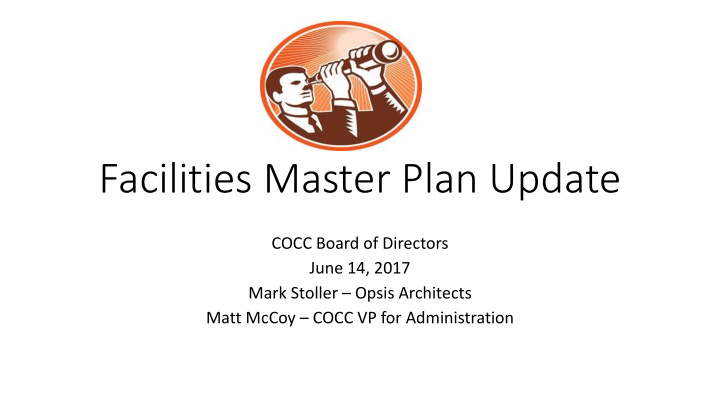



Facilities Master Plan Update COCC Board of Directors June 14, 2017 Mark Stoller – Opsis Architects Matt McCoy – COCC VP for Administration
Planning Context
Campus Master Plan Process
Visioning Purpose: Bridging the Gap External Analysis Internal Analysis Population Projections Historic Enrollment Analysis - Age - Age - Income - Full-Time /Part Time - Educational Attainment - Gender - Ethnicity - Ethnicity - Migration Patterns - FTE/Headcount Ratio - Placement Level Occupational/Labor Analysis Current Degrees/Certificates - Employment Projections - Industry Outlook - Technical Degrees Granted - Unemployment - Transfer - Labor Force Skills - Workforce Training Visioning and Enrollment Management High School Projections Institutional - Recruitment/Marketing Trends Strategy Best Practices Retention Rates/ Grad Rates Competition Faculty Ratios Participation Rates Distance Learning Technology
• Develop a better understanding of the campus and decisions being made • Look beyond the strategic plan with a glimpse into 2025-2027 • Open dialogue about some of the ideas and images conveyed in this presentation: - Consistency with the vision, mission, and values of COCC? - Relevancy for COCC community and students - Which of these concepts are critical to the future of LCCC? • Developing a Campus Master Plan - What should we know about COCC? - What should we not overlook? - What is the most important issue that MUST be addressed? • Specific vision or goals for the master plan? “ The goal of campus master planning is to assure that facilities and infrastructure resources are available to accomplish future strategic institutional and academic goals”.
Campus Planning Alignment Strategic Plan: 2013-2018 2013 2018 Academic Master Plans: 2015- 2018 2015-16 2018 Campus Master Plan: 2017-2027 2017 2027 Questions for Review a. What strategic objectives have been accomplished? b. Which objectives are still being implemented? c. As current strategic plan expires in 2018, is a new college-wide vision emerging? d. Are new directions emerging to align with the Facilities Master Plan?
Internal Analysis • Historical Enrollment • FTE by Campus – Credit and Continuing Education • Enrollment by Activity – Credit and Continuing Education • Completions • Retention • Existing Facilities • Purpose of Campuses • Impact of Future Enrollment
External Analysis • National Economic Indicators • National Degree Trends • State Population Growth & Forecast • Net Oregon Migration and Degrees • Oregon 4-Year Grad Rate • Oregon High School Grad Projections • Oregon Educational Attainment Level • COCC Participation Rate by Counties in District • Region Population Estimates by County • State Job Growth
The 21 st Century Campus Globalization 21 st Century Societal Technology Expectations Student Expectations and Campus of Preparation 21 st Century the 21 st Teaching Cultural Shifts Century Digital Literacy Higher Ed Competition 21 st Century Learning Faculty Training and Preparation Community College Futures Conference, Spring 2016
Palfrey & Gasser, 2008
Classroom Challenges for Gen Z Learning Technology Collaboration Spaces Services Gen Z still Require 24/7 values support to match Gen Z prefers a quiet meeting in their expectation space to use for ‘instant’ person technology and study access Meld individual work with group collaboration Libraries are becoming the quiet study and collaboration spaces Example: Work for Gen Z individual on Google Doc during group meeting Source: Gen Z Goes to College, Cory Seemiller
More Technology in Active Learning Spaces
Collaborative Spaces Promote Student Interaction
Student Services at Multi-Campus College • Student Services Availability • Student Orientation • Pre-Assessment Preparation • Placement Testing • College Success Programs • Focus on Specific Populations • Multiple Advising Modes/Systems
Centers of Excellence & Workforce Partnerships • Address a key area in which future job growth is expected • Is a key supplier of skilled workers for local employers • Enrolls a large number of students year after year • Demonstrates high success rates • Offers innovative educational programs • Has broad impact on the region • Uses state-of-the-art facilities • Receives national recognition in its field
Recommend
More recommend